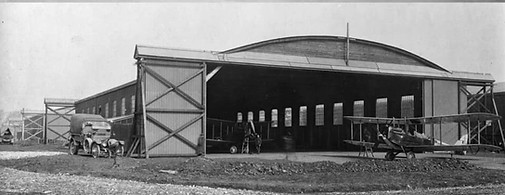
RAF Harlaxton
During the First World war Harlaxton saw a significant development just outside the village with the creation of a flying school for the Royal flying Corps on the ridge behind the manor and Trench warfare school in its grounds.
Constructed as a Royal Flying Corps aerodrome in November 1916 as a flying training establishment, Harlaxton aerodrome had three grassed runways laid out in an equilateral triangle, unusually oriented to the north.
The first squadron to operate out of the field was No. 44 Reserve Squadron RFC.
In January 1917 Royal Flying Corps' No.98 Squadron was formed at Harlaxton from elements drawn from a group of Australian pilots already in the UK in other training squadrons. Equipped with DH5s it deployed to France in September 1917, specialising in ground attack owing to the shortcomings of its equipment.
Training losses through the war were heavy - 33 men killed plus scores of others injured. Three are buried in Harlaxton churchyard – Stanley Muir (Aus) , Stanley Rutledge and Alick Charlesworth (both Can). Further information about these men and the airfield can be read in the excellent book by Ed Bujak, a lecturer at Harlaxton College, called “Reckless Fellows”.
It also saw the first influx of Americans into the village with some flyers and a significant number of groundcrew arriving from the USA in 1917.
Between 1917 and the end of the war the following training squadrons flew out of Harlaxton, 3, 26, 40, 53, 64 and 98
In 1919 the station was mothballed and placed on a care and maintenance basis between the wars.




Stanley Keith Muir
Stanley was born on 6th April, 1892 at Elsternwick, Melbourne, Victoria, Australia to parents John Franklin Muir & Josephine Muir (nee Holmes).
He joined the Royal flying Corps as a Captain in 1916 and after active service abroad he returned to England and joined No. 68 Squadron R.F.C. at Harlaxton, Lincolnshire, England from Overseas on 18th August, 1917 as an instructor.
He died aged 25 on 12 Sept. 1917 as a result of a flying accident and is one of three flyers from Harlaxton buried in the village churchyard.
The Grantham Journal, Grantham, reported on 15 September, 1917; “AUSTRALIAN AIRMAN KILLED. In an Eastern Counties Camp, on Thursday, an inquest was held respecting the death of Captain Stanley Keith Muir, aged 25, of the Australian Flying Corps, whose home is in Melbourne.
Deceased was stated to be a skilled and experienced pilot. Second-Lieut. G. C. Wilson, A.F.C., said that on Wednesday he saw Captain Muir turn the machine on its back and glide for a short distance upside down. He was at this time about 1,200 feet up. He pulled the machine out in the ordinary way, and when at about 800 feet up the aeroplane attained its normal flying position.
Directly afterwards the right-hand bottom wing appeared to collapse in the centre, and immediately the top wing crumpled up, causing the machine to spin to the ground. He watched Captain Muir all the time during this particular flight, and he considered there was no unnecessary strain put on the machine, which was practically a new one. The further evidence showed that the machine was in perfect working order when it ascended. The jury returned a verdict of “Accidental death,” and expressed the opinion that accident was caused through some structural defect in the part of the machine which first broke, and that strict investigations should be made possible to ascertain the cause of the accident, and prevent similar accidents in the future.”
WW2 and beyond.
In Oct 1939 Harlaxton was in use as the bombing range for 12 FTS and in May 1940 it was described as a temporary practice bombing range for RAFC Cranwell and Spitalgate .
1942 RAF Harlaxton reopened as a satellite field and relief landing ground for the flying training squadron posted to RAF Spitalgate, Grantham under the command of No. 21 (Training) Group RAF.
Harlaxton Manor was requisitioned by the War Department and utilised as the station's officers' mess until January 1944 when it transferred over to 1 Para Div.
The RAF station continued as a satellite field, but finally closed in 1957 when it’s grass runways were unsuitable for the newer jet fighters being used for pilot training at Cranwell.
Baxter's Spitfire
RAF Harlaxton gives the village a (very) tenuous connection with Raymond Baxter, who used to present Tomorrow’s World the weekly science and technology programme on BBC in the late 1960s 70s and 80s.
Baxter flew Spitfires during the war and one aircraft his log books shows he flew regularly, when he was with 602 Squadron, was SM288, a Spitfire mk XVI. Indeed, it is recorded as was the "usual" aircraft of Raymond Baxter between December 1944 and May 1945.
When 602 Squadron was disbanded at the end of hostilities in Europe in May 1945 the aircraft were transferred to other squadrons. Spitfire SM288 found itself issued to 17 Squadron based at RAF Harlaxton.
Sadly, this Spitfire, previously flown by Baxter, was written off in June 1946 when its engine failed due to a serious breakup of the big end bearings and connecting rods just after take-off at an altitude of 400 feet. The stricken aircraft turned back to the grass strip at RAF Harlaxton and made a wheels-up forced landing short of the runway, with the pilot no doubt shaken but unharmed.